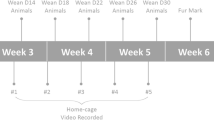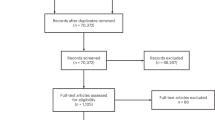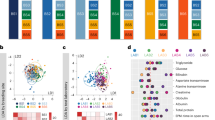Abstract
Aged rodents present unique concerns for both husbandry staff and investigators. Choosing the correct rodent model and providing the appropriate care are important elements for successful use of rodent models in biogerontology research programs. The author discusses issues to be evaluated when housing and using aged rodents.
This is a preview of subscription content, access via your institution
Access options
Subscribe to this journal
We are sorry, but there is no personal subscription option available for your country.
Buy this article
- Purchase on Springer Link
- Instant access to full article PDF
Prices may be subject to local taxes which are calculated during checkout



Similar content being viewed by others
References
Turturro, A., Witt, W.W., Lewis, S., Hass, B.S., Lipman, R.D. & Hart, R.W. Growth curves and survival characteristics of the animals used in the biomarkers of aging program. J. Gerontol. A Biol. Sci. Med. Sci. 54(11), B492–B501 (1999).
Bellinger, D., Tran, L., Kang, J.I., Lubahn, C., Felton, D.L. & Lorton, D. Age-related changes in noradrenergic sympathetic innervation of the rat spleen is strain dependent. Brain Behav. Immun. 16(3), 247–261 (2002).
Wolf, N.S., Li, Y., Pendergrass, W., Schmeider, C. & Turturro, A. Normal mouse and rats strains as models for age-related cataract and the effect of caloric restriction on its development. Exp. Eye Res. 70(5), 683–692 (2000).
Jepsen, K.J., Akkus, O.J., Majeska, R.J. & Nadeau, J.H. Hierarchical relationship between bone traits and mechanical properties in inbred mice. Mamm. Genome 14(2), 97–104 (2003).
Sheng, M.H., Baylink, D.J., Beamer, W.G., Donahue, L.R., Lau, K.H, & Wergedal, J.E. Regulation of bone volume is different in the metaphyses of the femur and vertebra of C3H/HeJ and C57BL/6J mice. Bone 30(3), 486–491 (2002).
Rosen, C.J., Beamer, W.G. & Donahue, L.R. Defining the genetics of osteoporosis: using the mouse to understand the man. Osteoporos. Int. 12(10), 803–810 (2001).
Lipman, R.D., Chrisp, C.E., Hazzard, D.G. & Bronson, R.T. Pathologic characterization of Brown Norway, Brown Norway × Fischer 344, and Fischer 344 × Brown Norway rats with relation to age. J. Gerontol. A Biol. Sci. Med. Sci. 51(1), B54–B59 (1996).
Lipman, R.D., Dallal, G.E. & Bronson, R.T. Effects of genotype and diet on age-related lesions in ad libitum fed and calorie-restricted F344, BN and BNF3F1 rats. J. Gerontol. A Biol. Sci. Med. Sci. 54(11), B478–B491 (1999).
Lipman, R.D. et al. Disease incidence and longevity are altered by dietary antioxidant supplementation initiated during middle age in C57BL/6 mice. Mech. Ageing Dev. 103(3), 269–284 (1988).
Zimmerman, J.A., Malloy, V., Krajcik, R. & Orentreich, N. Nutritional control of aging. Exp. Gerontol. 38(1–2), 47–52 (2003).
Iwasaki, K., Gleiser, C.A., Masoro, E.J., McMahan, C.A., Seo, E.J. & Yu, B.P. The influence of dietary protein source on longevity and age-related disease processes of Fischer rats. J. Gerontol. 43(1), B5–B12 (1988).
Turturro, A., Duffy, P., Hass, B., Kodell, R. & Hart, R. Survival characteristics and age-adjusted disease incidences in C57BL/6 mice fed a commonly used cereal-based diet modulated by dietary restriction. J. Gerontol. A Biol. Sci. Med. Sci. 57(11), B379–B389 (2002).
The Jackson Laboratory. Notice to users of JAX mice: C57BL/6J skin lesion problem eliminated (14 August 1997).
Turturro, A., Duffy, P., Hart, R. & Allaben, W.T. Rationale for the use of dietary control in toxicity studies—B6C3F1 mouse. Toxicol. Pathol. 24(6), 769–775 (1996).
Lipman, R.D., Gaillard, E.T., Harrison, D.E. & Bronson, R.T. Husbandry factors and the prevalence of age-related amyloidosis in mice. Lab. Anim. Sci. 43(5), 439–444 (1993).
Olsson, A.S. & Dahlborn, K. Improving housing conditions for laboratory mice: a review of “environmental enrichment”. Lab. Anim. 36(3), 243–270 (2002).
Mattson, M.P., Duan, W., Lee, J & Guo, Z. Suppression of brain aging and neurodegenerative disorders by dietary restriction and environmental enrichment: molecular mechanisms. Mech. Ageing Dev. 122(7), 757–778 (2001).
Frick, K.M., Stearns, N.A., Pan, J.Y. & Berger-Sweeney, J. Effects of environmental enrichment on spatial memory and neurochemistry in middle-aged mice. Learn. Mem. 10(3), 187–198 (2003).
Tillerson, J.L., Caudle, W.M., Reveron, M.E. & Miller, G.W. Exercise induces behavioral recovery and attenuates neurochemical deficits in rodent models of Parkinson's Disease. Neuroscience 119(3), 899–911 (2003).
Powell, S.B., Newman, H.A., McDonald, T.A., Bugenhagen, P. & Lewis, M.H. Development of spontaneous stereotyped behavior in deer mice: effects of early and late exposure to a more complex environment. Dev. Psychobiol. 37(2), 100–108 (2000).
Turner, C.A., Lewis, M.H. & King, M.A. Environmental enrichment: effects on stereotyped behavior and dendritic morphology. Dev. Psychobiol. 43(1), 20–27 (2003).
Marashi, V., Barnekow, A., Ossendorf, E. & Sachser, N. Effects of different forms of environmental enrichment on behavioral, endocrinological, and immunological parameters in male mice. Horm. Behav. 43(2), 281–292 (2003).
Van de Weerd, H.A., Aarsen, E.L., Mulder, A., Kruitwagen, C.L., Hendricksen, C.F. & Baumans, V. Effects of environmental enrichment for mice: variation in experimental results. J. Appl. Anim. Welf. Sci. 5(2), 87–109 (2002).
Campisi, J. & Fleshner, M. Role of extracellular HSP72 in acute stress-induced potentiation of innate immunity in active rats. J. Appl. Physiol. 94(1), 43–52 (2003).
Hoffman-Goetz, L., Zajchowski, S. & Aldred, A. Impact of treadmill exercise on early apoptotic cells in mouse thymus and spleen. Life Sci. 64(3), 191–200 (1999).
Elphick, G.F., Weiseler-Frank, J., Greenwood, B.N., Campisi, J. & Fleshner, M. B-1 cell (CD5+/CD11b+) numbers and nIgM levels are elevated in physically active vs. sedentary rats. J. Appl. Physiol. 95(1), 199–206 (2003).
Elphick, G.F., Greenwood, B.N., Campisi, J. & Fleshner, M. Increased serum nIgM in voluntarily physically active rats: a potential role for B-1 cells. J. Appl. Physiol. 94(2), 660–667 (2003).
Tsai, P.P., Pachowsky, U., Stelzer, H.D. & Hackbarth, H. Impact of environmental enrichment in mice. 1: Effect of housing conditions on body weight, organ weights and haematology in different strains. Lab. Anim. 36(4), 411–419 (2002).
Author information
Authors and Affiliations
Rights and permissions
About this article
Cite this article
Nadon, N. Maintaining Aged Rodents for Biogerontology Research. Lab Anim 33, 36–41 (2004). https://doi.org/10.1038/laban0904-36
Received:
Accepted:
Issue Date:
DOI: https://doi.org/10.1038/laban0904-36
This article is cited by
-
Improvement of Bone Quality in Gonad-Intact Middle-Aged Male Rats by Long-Chain n-3 Polyunsaturated Fatty Acid
Calcified Tissue International (2007)



